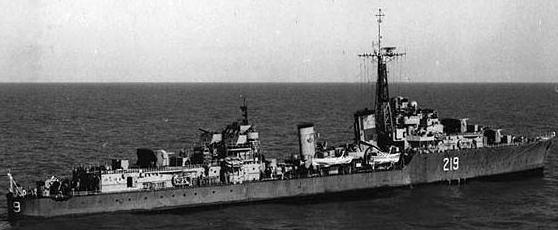 |
| An early 1950's photo of ATHABASKAN 219 |
Although Canada had decided to construct four Tribals during World War 2, her own yards were kept busy building urgently needed escort vessels and merchantmen. There was also a shortage of technical equipment which had to be brought over from the UK. As a result, not one of the Canadian-built Tribals saw service during the Second World War. The last of her class to be completed, "Athabee" was commissioned at Halifax on 20th January 1948. After the main part of her crew arrived from British Columbia, sea trials were completed and the ATHABASKAN sailed to her appointed station on the West Coast on 15th May, 1948. There, she spent the first part of her service career with CAYUGA and other RCN ships showing the flag along the Pacific shores of Canada and the US.
 |
| An early 1950's photo of ATHABASKAN 219 |
For ATHABASKAN and CAYUGA, the years between 1955 and 1959 meant pilotage and amphibious exercises in the narrow inlets of British Columbia, air defence, gunnery and anti-submarine exercises off California and Pearl Harbour, goodwill visits, reviews, regattas, refits and sea trials. When this training role was completed, in January 1959, she left for the east coast to become part of a homogeneous Tribal class squadron. In October of 1963, she was in European waters once again only this time it was to hold a memorial service over the resting place of her namesake, the first ATHABASKAN. After five years of training cruises and NATO exercises she was placed in reserve at Halifax and on 21st April 1966, paid off for disposal. ATHABASKAN'S last voyage began at the end of a tow line in July 1969 - to be broken up at La Spezia, Italy.
SHIP'S BADGE
BLAZON: On a field Argent, a North American Indian clad in buckskin breeches, leggings and beaded moccasins, but bare to the waist except for a necklace of bear's claws and blue shells and ear ornaments of the last. The Indian wears the full-feathered head-dress and is mounted bare-back upon an Indian pony being halted from the trot. The Indian holds a red bow and arrow in the "ready" position, the latter pointing down.
SIGNIFICANCE: This badge design is based on the one which had been planned by officers of the original Athabaskan, but was not completed before that ship was lost in action with the enemy. The elements of the originally planned design have been retained in the new official badge as a special fighting tribute to those gallant officers and men who went down with their ship fighting.
Those of the original ship's company who survived that fateful night, as well as those now serving in the new Athabaskan, may take the utmost pride in their badge for it commemorates an action that ranks with the best in British naval history of courage and devotion to duty.
SHIP'S COLOURS: White and Scarlet
MOTTO: "We fight as one"
BATTLE HONOURS: Korea 1950-1953